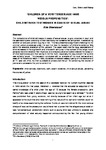‘CHILDREN OF A VERY TENDER AGE HAVE VICIOUS PROPENSITIES’: CHILD WITNESS TESTIMONIES IN CASES OF SEXUAL ABUSE
| dc.contributor.author | Stevenson, Kim | |
| dc.date.accessioned | 2018-02-06T11:13:53Z | |
| dc.date.available | 2018-02-06T11:13:53Z | |
| dc.date.issued | 2017-07-28 | |
| dc.identifier.issn | 2045-9238 | |
| dc.identifier.uri | http://hdl.handle.net/10026.1/10737 | |
| dc.description.abstract |
The competency of child witnesses in cases of sexual abuse to give evidence in court and the admissibility and credibility of their testimony is a fundamental component in establishing whether an accused person is guilty or not. This has presented a significant challenge to the criminal justice process as under the common law the reception of children’s evidence falls within the absolute discretion of the judiciary. The paper examines the legal expectations of child witnesses in the eighteenth and nineteenth centuries in the context of the religio-moral perspectives and debates that influenced and shaped judicial attitudes towards the reception of child testimonies and their ability to tell the truth, especially the requirement that a child was suitably ‘pious’. The discussion concludes with an analysis of the most ‘extraordinary’ case of the Reverend Hatch in 1860, convicted of indecent assault partly on the testimony of an 11 year-old child, he then successfully prosecuted the girl for perverting the course of justice and persuaded the jury to convict her. | |
| dc.language.iso | en | |
| dc.publisher | SOLON | |
| dc.title | ‘CHILDREN OF A VERY TENDER AGE HAVE VICIOUS PROPENSITIES’: CHILD WITNESS TESTIMONIES IN CASES OF SEXUAL ABUSE | |
| dc.type | journal-article | |
| plymouth.journal | Law, Crime and History | |
| plymouth.organisational-group | /Plymouth | |
| plymouth.organisational-group | /Plymouth/Faculty of Arts, Humanities and Business | |
| plymouth.organisational-group | /Plymouth/Users by role | |
| dcterms.dateAccepted | 2017-07-10 | |
| dc.rights.embargoperiod | Not known | |
| rioxxterms.licenseref.uri | http://www.rioxx.net/licenses/all-rights-reserved | |
| rioxxterms.licenseref.startdate | 2017-07-28 | |
| rioxxterms.type | Journal Article/Review |


